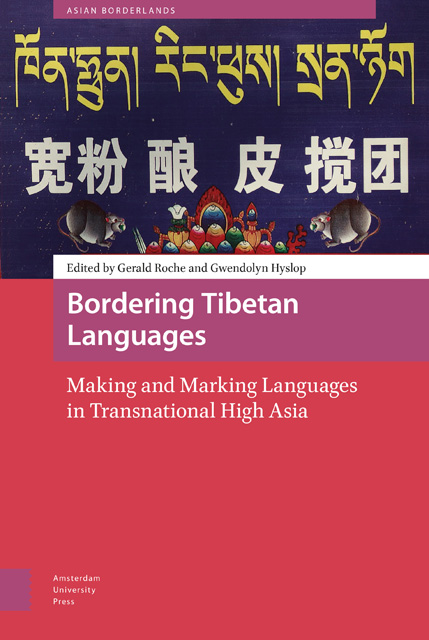Book contents
- Frontmatter
- Table of Contents
- Acknowledgements
- About the Cover Image
- 1 Introduction: Bordering Tibetan Languages: Making and Marking Languages in Transnational High Asia
- 2 Playing with Language Boundaries: Heteroglot Standard Language Ideology and Linguistic Belonging among Amdo Children
- 3 The Role of Classical Tibetan (Chöke) on the Development of Kurtöp, a Language of Bhutan
- 4 Reimagining Rongring without Tibetan Buddhist Influence
- 5 Glottonyms, Identity, and Language Recognition in the Eastern Tibetosphere
- 6 On the Yak Horns of a Dilemma: Diverging Standards in Diaspora Tibetan
- 7 Changing Identity and Linguistic Practices in Nubri: Veiled Language Endangerment in the Nepalese Tibetosphere
- 8 Borderline Dominance: Transnational Tibetan Language Politics in the Himalayas
- 9 Borders: In Conclusion
- Tibetan Language Summaries
- Asian Borderlands
- Index
2 - Playing with Language Boundaries: Heteroglot Standard Language Ideology and Linguistic Belonging among Amdo Children
Published online by Cambridge University Press: 24 November 2022
- Frontmatter
- Table of Contents
- Acknowledgements
- About the Cover Image
- 1 Introduction: Bordering Tibetan Languages: Making and Marking Languages in Transnational High Asia
- 2 Playing with Language Boundaries: Heteroglot Standard Language Ideology and Linguistic Belonging among Amdo Children
- 3 The Role of Classical Tibetan (Chöke) on the Development of Kurtöp, a Language of Bhutan
- 4 Reimagining Rongring without Tibetan Buddhist Influence
- 5 Glottonyms, Identity, and Language Recognition in the Eastern Tibetosphere
- 6 On the Yak Horns of a Dilemma: Diverging Standards in Diaspora Tibetan
- 7 Changing Identity and Linguistic Practices in Nubri: Veiled Language Endangerment in the Nepalese Tibetosphere
- 8 Borderline Dominance: Transnational Tibetan Language Politics in the Himalayas
- 9 Borders: In Conclusion
- Tibetan Language Summaries
- Asian Borderlands
- Index
Summary
Abstract
This chapter examines the consequences of language standardisation for children in contemporary Amdo (Qinghai, China). Drawing on fifteen months of ethnographic and linguistic fieldwork documenting children's language practices in a region historically characterised by linguistic convergence, I show how the youngest generation of Amdo Tibetan speakers is defining social belonging by marking a boundary between the Tibetan and Chinese languages. I argue that children's linguistic boundary-marking responds to ‘heteroglot standard language ideology’, a moral orientation towards Tibetan and Chinese as discrete languages that has arisen amidst anxieties over assimilation and leads children to identify with a rural/urban binary. Because this binary entrenches a hierarchy between Tibetan and Chinese, community aspirations for socioeconomic mobility encourage children to speak standard Mandarin.
Keywords: language boundaries, language standardisation, language ideologies, Tibetan language, Amdo Tibet
Introduction
It was a midday in June 2018. I was in an Amdo Tibetan village, in a small valley nestled beside the Yellow River in Qinghai, China. Three children sat atop a stationary bicycle in an exercise plot gifted by the county government. Six-year-old Dolma was first, trailed by her six-year-old cousin Dawa and four-year-old sister Lhamo. Suddenly, Dolma braked the pedals, pointing. Two new children stood at the gate to the exercise plot. Hesitating, they opened the gate and entered. Dolma dismounted the bike and called to Lhamo and Dawa in Amdo Tibetan “ŋa-zo dewa-kə ma-re-pa” (I guess they’re not from our village). Dawa and Lhamo ran to catch up with Dolma, while Dolma greeted the newcomers in hesitating Mandarin, saying, “xiao3 peng2you!” (little friend!).
With her decision to switch from spoken Amdo to Mandarin, Dolma marked this arrival as a cross-linguistic encounter. The other children followed suit. They stood in two separate groups. In Mandarin, they discussed the locations of their schools. Dolma, Dawa, and Lhamo attend the local village preschool. The other two children attend a preschool in Xining city, the provincial capital located about 250 kilometres north-east. After several moments, the children departed from their meeting point. Dolma, Dawa, and Lhamo returned to the bicycle, while the newcomers skipped towards a small plot of grass.
- Type
- Chapter
- Information
- Bordering Tibetan LanguagesMaking and Marking Languages in Transnational High Asia, pp. 31 - 52Publisher: Amsterdam University PressPrint publication year: 2022

